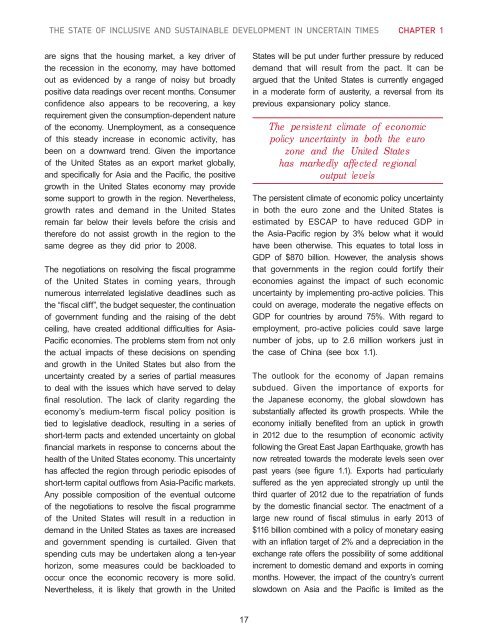Full Report - Subregional Office for East and North-East Asia - escap
Full Report - Subregional Office for East and North-East Asia - escap
Full Report - Subregional Office for East and North-East Asia - escap
You also want an ePaper? Increase the reach of your titles
YUMPU automatically turns print PDFs into web optimized ePapers that Google loves.
THE STATE OF INCLUSIVE AND SUSTAINABLE DEVELOPMENT IN UNCERTAIN TIMES CHAPTER 1<br />
are signs that the housing market, a key driver of<br />
the recession in the economy, may have bottomed<br />
out as evidenced by a range of noisy but broadly<br />
positive data readings over recent months. Consumer<br />
confidence also appears to be recovering, a key<br />
requirement given the consumption-dependent nature<br />
of the economy. Unemployment, as a consequence<br />
of this steady increase in economic activity, has<br />
been on a downward trend. Given the importance<br />
of the United States as an export market globally,<br />
<strong>and</strong> specifically <strong>for</strong> <strong>Asia</strong> <strong>and</strong> the Pacific, the positive<br />
growth in the United States economy may provide<br />
some support to growth in the region. Nevertheless,<br />
growth rates <strong>and</strong> dem<strong>and</strong> in the United States<br />
remain far below their levels be<strong>for</strong>e the crisis <strong>and</strong><br />
there<strong>for</strong>e do not assist growth in the region to the<br />
same degree as they did prior to 2008.<br />
The negotiations on resolving the fiscal programme<br />
of the United States in coming years, through<br />
numerous interrelated legislative deadlines such as<br />
the “fiscal cliff”, the budget sequester, the continuation<br />
of government funding <strong>and</strong> the raising of the debt<br />
ceiling, have created additional difficulties <strong>for</strong> <strong>Asia</strong>-<br />
Pacific economies. The problems stem from not only<br />
the actual impacts of these decisions on spending<br />
<strong>and</strong> growth in the United States but also from the<br />
uncertainty created by a series of partial measures<br />
to deal with the issues which have served to delay<br />
final resolution. The lack of clarity regarding the<br />
economy’s medium-term fiscal policy position is<br />
tied to legislative deadlock, resulting in a series of<br />
short-term pacts <strong>and</strong> extended uncertainty on global<br />
financial markets in response to concerns about the<br />
health of the United States economy. This uncertainty<br />
has affected the region through periodic episodes of<br />
short-term capital outflows from <strong>Asia</strong>-Pacific markets.<br />
Any possible composition of the eventual outcome<br />
of the negotiations to resolve the fiscal programme<br />
of the United States will result in a reduction in<br />
dem<strong>and</strong> in the United States as taxes are increased<br />
<strong>and</strong> government spending is curtailed. Given that<br />
spending cuts may be undertaken along a ten-year<br />
horizon, some measures could be backloaded to<br />
occur once the economic recovery is more solid.<br />
Nevertheless, it is likely that growth in the United<br />
States will be put under further pressure by reduced<br />
dem<strong>and</strong> that will result from the pact. It can be<br />
argued that the United States is currently engaged<br />
in a moderate <strong>for</strong>m of austerity, a reversal from its<br />
previous expansionary policy stance.<br />
The persistent climate of economic<br />
policy uncertainty in both the euro<br />
zone <strong>and</strong> the United States<br />
has markedly affected regional<br />
output levels<br />
The persistent climate of economic policy uncertainty<br />
in both the euro zone <strong>and</strong> the United States is<br />
estimated by ESCAP to have reduced GDP in<br />
the <strong>Asia</strong>-Pacific region by 3% below what it would<br />
have been otherwise. This equates to total loss in<br />
GDP of $870 billion. However, the analysis shows<br />
that governments in the region could <strong>for</strong>tify their<br />
economies against the impact of such economic<br />
uncertainty by implementing pro-active policies. This<br />
could on average, moderate the negative effects on<br />
GDP <strong>for</strong> countries by around 75%. With regard to<br />
employment, pro-active policies could save large<br />
number of jobs, up to 2.6 million workers just in<br />
the case of China (see box 1.1).<br />
The outlook <strong>for</strong> the economy of Japan remains<br />
subdued. Given the importance of exports <strong>for</strong><br />
the Japanese economy, the global slowdown has<br />
substantially affected its growth prospects. While the<br />
economy initially benefited from an uptick in growth<br />
in 2012 due to the resumption of economic activity<br />
following the Great <strong>East</strong> Japan Earthquake, growth has<br />
now retreated towards the moderate levels seen over<br />
past years (see figure 1.1). Exports had particularly<br />
suffered as the yen appreciated strongly up until the<br />
third quarter of 2012 due to the repatriation of funds<br />
by the domestic financial sector. The enactment of a<br />
large new round of fiscal stimulus in early 2013 of<br />
$116 billion combined with a policy of monetary easing<br />
with an inflation target of 2% <strong>and</strong> a depreciation in the<br />
exchange rate offers the possibility of some additional<br />
increment to domestic dem<strong>and</strong> <strong>and</strong> exports in coming<br />
months. However, the impact of the country’s current<br />
slowdown on <strong>Asia</strong> <strong>and</strong> the Pacific is limited as the<br />
17












